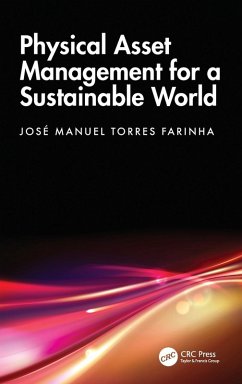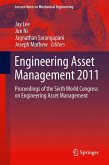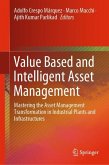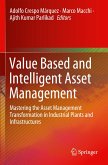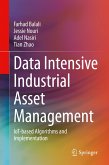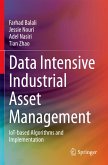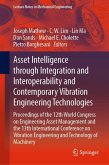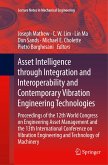José Manuel Torres Farinha
Physical Asset Management for a Sustainable World
José Manuel Torres Farinha
Physical Asset Management for a Sustainable World
- Gebundenes Buch
- Merkliste
- Auf die Merkliste
- Bewerten Bewerten
- Teilen
- Produkt teilen
- Produkterinnerung
- Produkterinnerung
The book describes techniques, tools and models about Engineering Maintenance and and Life Cycle Models, aimed at the efficiently managing of assets. It presents new asset management models including quantitative decision support tools for life management of physical assets supported by pertinent case studies.
Andere Kunden interessierten sich auch für
![Engineering Asset Management 2011 Engineering Asset Management 2011]() Engineering Asset Management 2011150,99 €
Engineering Asset Management 2011150,99 €![Value Based and Intelligent Asset Management Value Based and Intelligent Asset Management]() Value Based and Intelligent Asset Management75,99 €
Value Based and Intelligent Asset Management75,99 €![Value Based and Intelligent Asset Management Value Based and Intelligent Asset Management]() Value Based and Intelligent Asset Management75,99 €
Value Based and Intelligent Asset Management75,99 €![Data Intensive Industrial Asset Management Data Intensive Industrial Asset Management]() Farhad BalaliData Intensive Industrial Asset Management75,99 €
Farhad BalaliData Intensive Industrial Asset Management75,99 €![Data Intensive Industrial Asset Management Data Intensive Industrial Asset Management]() Farhad BalaliData Intensive Industrial Asset Management75,99 €
Farhad BalaliData Intensive Industrial Asset Management75,99 €![Asset Intelligence through Integration and Interoperability and Contemporary Vibration Engineering Technologies Asset Intelligence through Integration and Interoperability and Contemporary Vibration Engineering Technologies]() Asset Intelligence through Integration and Interoperability and Contemporary Vibration Engineering Technologies150,99 €
Asset Intelligence through Integration and Interoperability and Contemporary Vibration Engineering Technologies150,99 €![Asset Intelligence through Integration and Interoperability and Contemporary Vibration Engineering Technologies Asset Intelligence through Integration and Interoperability and Contemporary Vibration Engineering Technologies]() Asset Intelligence through Integration and Interoperability and Contemporary Vibration Engineering Technologies213,99 €
Asset Intelligence through Integration and Interoperability and Contemporary Vibration Engineering Technologies213,99 €-
-
-
The book describes techniques, tools and models about Engineering Maintenance and and Life Cycle Models, aimed at the efficiently managing of assets. It presents new asset management models including quantitative decision support tools for life management of physical assets supported by pertinent case studies.
Hinweis: Dieser Artikel kann nur an eine deutsche Lieferadresse ausgeliefert werden.
Hinweis: Dieser Artikel kann nur an eine deutsche Lieferadresse ausgeliefert werden.
Produktdetails
- Produktdetails
- Verlag: CRC Press
- Seitenzahl: 464
- Erscheinungstermin: 1. Oktober 2024
- Englisch
- Abmessung: 240mm x 161mm x 29mm
- Gewicht: 857g
- ISBN-13: 9781032428352
- ISBN-10: 103242835X
- Artikelnr.: 70374430
- Herstellerkennzeichnung
- Libri GmbH
- Europaallee 1
- 36244 Bad Hersfeld
- gpsr@libri.de
- Verlag: CRC Press
- Seitenzahl: 464
- Erscheinungstermin: 1. Oktober 2024
- Englisch
- Abmessung: 240mm x 161mm x 29mm
- Gewicht: 857g
- ISBN-13: 9781032428352
- ISBN-10: 103242835X
- Artikelnr.: 70374430
- Herstellerkennzeichnung
- Libri GmbH
- Europaallee 1
- 36244 Bad Hersfeld
- gpsr@libri.de
José Manuel Torres Farinha has Habilitation in Electrical and Computer Engineering, a PhD in Mechanical Engineering and a degree in Electrical Engineering, option Energy. He is a National Defence Auditor. He is Full Professor in Coimbra Polytechnic Institute (IPC) and its former President. He is the Coordinator of the Master's Degree in Engineering and Management of Physical Assets in IPC. He has completed several PhD supervisions and dozens of Master's degree orientations. He has published three books, two in National edition and one in International edition. He has more than 250 publications - articles in indexed and non-indexed international journals, in national magazines and in proceedings of international and national congresses. He has several registered patents (National and International). He is Specialist Member of Industrial Maintenance Specialization and a Counsellor Member of the Portuguese Association of Engineers.
PART I Life Cycle Models. 1 Life Cycle Cost of Physical Assets. 1.1
Introduction. 1.2 Life Cycle Models. 1.3 Economic Life Cycle. 1.4
Performance Indicators. 1.5 Investment Analysis Methods. 1.6 New Economic
Replacement Models. 1.7 Reserve Set. 1.8 Life Cycle Considering Incomes.
1.9 Simulation of Methods Application. References. 2 Life Cycle Investment
of Physical Assets. 2.1 Introduction. 2.2 The Model of a Holistic Approach
of the Physical Assets Life Cycle. 2.3 LCI Considering Maintenance and
Non¿Production. 2.4 Case Study Simulation. 2.5 Conclusions. References. 3
Life Cycle of Physical Assets with Recovery. 3.1 Introduction. 3.2
Methodology. 3.3 Basic Concepts to Support Math Models. 3.4 Behaviour of
the Physical Asset Value along Time. 3.5 Production Economic Movements. 3.6
Functioning Economic Movements. 3.7 Global Movements Analysis. 3.8 Return
on Investment. 3.9 Models Validation and Discussion. 3.10 Conclusions.
PART II Maintenance Methodologies. 4 Maintenance Types and Strategies. 4.1
Introduction. 4.2 Predetermined Maintenance. 4.3 Corrective Maintenance.
4.4 Enterprise Asset Management Systems. 4.5 Maintenance Performance.
References. 5 Maintenance Algorithms. 5.1 Introduction. 5.2 Stochastic
Algorithms. 5.3 Artificial Intelligence Algorithms. References. PART III
Standards. 6 Maintenance Standards. 6.1 Introduction. 6.2 Characterization
of Maintenance Standard NP 4492. 6.3 Diagnosis of the Maintenance State.
6.4 Diagnosis to Implement the Standard NP 4492. 6.5 Economic Implications
of Implementing Maintenance Standards. Reference. 7 Norms of Physical
Assets Management. 7.1 Introduction. 7.2 Main Requisites of Physical Asset
Norms. 7.3 Diagnosis to Implement Physical Asset Norms. 7.4 Quantitative
Evaluation to Implement Physical Asset Norms. 8 Risk Norms. 8.1
Introduction. 8.2 Characterization of Risk Norms. 8.3 Diagnosis to
Implement Risk Norms. 8.4 Quantitative Evaluation about the Implementation
of Risk Norms. Reference. 9 Energy Norms. 9.1 Introduction. 9.2
Characterization of Energy Norms. 9.3 Diagnosis to Implement Energy Norms.
9.4 Quantitative Evaluation about the Implementation of Energy Norms. 10
Environmental Norms. 10.1 Introduction. 10.2 Characterization of
Environmental Norms. 10.3 Diagnosis to Implement Environmental Norms. 10.4
Quantitative Evaluation about the Implementation of Environmental Norms.
Reference.
Introduction. 1.2 Life Cycle Models. 1.3 Economic Life Cycle. 1.4
Performance Indicators. 1.5 Investment Analysis Methods. 1.6 New Economic
Replacement Models. 1.7 Reserve Set. 1.8 Life Cycle Considering Incomes.
1.9 Simulation of Methods Application. References. 2 Life Cycle Investment
of Physical Assets. 2.1 Introduction. 2.2 The Model of a Holistic Approach
of the Physical Assets Life Cycle. 2.3 LCI Considering Maintenance and
Non¿Production. 2.4 Case Study Simulation. 2.5 Conclusions. References. 3
Life Cycle of Physical Assets with Recovery. 3.1 Introduction. 3.2
Methodology. 3.3 Basic Concepts to Support Math Models. 3.4 Behaviour of
the Physical Asset Value along Time. 3.5 Production Economic Movements. 3.6
Functioning Economic Movements. 3.7 Global Movements Analysis. 3.8 Return
on Investment. 3.9 Models Validation and Discussion. 3.10 Conclusions.
PART II Maintenance Methodologies. 4 Maintenance Types and Strategies. 4.1
Introduction. 4.2 Predetermined Maintenance. 4.3 Corrective Maintenance.
4.4 Enterprise Asset Management Systems. 4.5 Maintenance Performance.
References. 5 Maintenance Algorithms. 5.1 Introduction. 5.2 Stochastic
Algorithms. 5.3 Artificial Intelligence Algorithms. References. PART III
Standards. 6 Maintenance Standards. 6.1 Introduction. 6.2 Characterization
of Maintenance Standard NP 4492. 6.3 Diagnosis of the Maintenance State.
6.4 Diagnosis to Implement the Standard NP 4492. 6.5 Economic Implications
of Implementing Maintenance Standards. Reference. 7 Norms of Physical
Assets Management. 7.1 Introduction. 7.2 Main Requisites of Physical Asset
Norms. 7.3 Diagnosis to Implement Physical Asset Norms. 7.4 Quantitative
Evaluation to Implement Physical Asset Norms. 8 Risk Norms. 8.1
Introduction. 8.2 Characterization of Risk Norms. 8.3 Diagnosis to
Implement Risk Norms. 8.4 Quantitative Evaluation about the Implementation
of Risk Norms. Reference. 9 Energy Norms. 9.1 Introduction. 9.2
Characterization of Energy Norms. 9.3 Diagnosis to Implement Energy Norms.
9.4 Quantitative Evaluation about the Implementation of Energy Norms. 10
Environmental Norms. 10.1 Introduction. 10.2 Characterization of
Environmental Norms. 10.3 Diagnosis to Implement Environmental Norms. 10.4
Quantitative Evaluation about the Implementation of Environmental Norms.
Reference.
PART I Life Cycle Models. 1 Life Cycle Cost of Physical Assets. 1.1
Introduction. 1.2 Life Cycle Models. 1.3 Economic Life Cycle. 1.4
Performance Indicators. 1.5 Investment Analysis Methods. 1.6 New Economic
Replacement Models. 1.7 Reserve Set. 1.8 Life Cycle Considering Incomes.
1.9 Simulation of Methods Application. References. 2 Life Cycle Investment
of Physical Assets. 2.1 Introduction. 2.2 The Model of a Holistic Approach
of the Physical Assets Life Cycle. 2.3 LCI Considering Maintenance and
Non¿Production. 2.4 Case Study Simulation. 2.5 Conclusions. References. 3
Life Cycle of Physical Assets with Recovery. 3.1 Introduction. 3.2
Methodology. 3.3 Basic Concepts to Support Math Models. 3.4 Behaviour of
the Physical Asset Value along Time. 3.5 Production Economic Movements. 3.6
Functioning Economic Movements. 3.7 Global Movements Analysis. 3.8 Return
on Investment. 3.9 Models Validation and Discussion. 3.10 Conclusions.
PART II Maintenance Methodologies. 4 Maintenance Types and Strategies. 4.1
Introduction. 4.2 Predetermined Maintenance. 4.3 Corrective Maintenance.
4.4 Enterprise Asset Management Systems. 4.5 Maintenance Performance.
References. 5 Maintenance Algorithms. 5.1 Introduction. 5.2 Stochastic
Algorithms. 5.3 Artificial Intelligence Algorithms. References. PART III
Standards. 6 Maintenance Standards. 6.1 Introduction. 6.2 Characterization
of Maintenance Standard NP 4492. 6.3 Diagnosis of the Maintenance State.
6.4 Diagnosis to Implement the Standard NP 4492. 6.5 Economic Implications
of Implementing Maintenance Standards. Reference. 7 Norms of Physical
Assets Management. 7.1 Introduction. 7.2 Main Requisites of Physical Asset
Norms. 7.3 Diagnosis to Implement Physical Asset Norms. 7.4 Quantitative
Evaluation to Implement Physical Asset Norms. 8 Risk Norms. 8.1
Introduction. 8.2 Characterization of Risk Norms. 8.3 Diagnosis to
Implement Risk Norms. 8.4 Quantitative Evaluation about the Implementation
of Risk Norms. Reference. 9 Energy Norms. 9.1 Introduction. 9.2
Characterization of Energy Norms. 9.3 Diagnosis to Implement Energy Norms.
9.4 Quantitative Evaluation about the Implementation of Energy Norms. 10
Environmental Norms. 10.1 Introduction. 10.2 Characterization of
Environmental Norms. 10.3 Diagnosis to Implement Environmental Norms. 10.4
Quantitative Evaluation about the Implementation of Environmental Norms.
Reference.
Introduction. 1.2 Life Cycle Models. 1.3 Economic Life Cycle. 1.4
Performance Indicators. 1.5 Investment Analysis Methods. 1.6 New Economic
Replacement Models. 1.7 Reserve Set. 1.8 Life Cycle Considering Incomes.
1.9 Simulation of Methods Application. References. 2 Life Cycle Investment
of Physical Assets. 2.1 Introduction. 2.2 The Model of a Holistic Approach
of the Physical Assets Life Cycle. 2.3 LCI Considering Maintenance and
Non¿Production. 2.4 Case Study Simulation. 2.5 Conclusions. References. 3
Life Cycle of Physical Assets with Recovery. 3.1 Introduction. 3.2
Methodology. 3.3 Basic Concepts to Support Math Models. 3.4 Behaviour of
the Physical Asset Value along Time. 3.5 Production Economic Movements. 3.6
Functioning Economic Movements. 3.7 Global Movements Analysis. 3.8 Return
on Investment. 3.9 Models Validation and Discussion. 3.10 Conclusions.
PART II Maintenance Methodologies. 4 Maintenance Types and Strategies. 4.1
Introduction. 4.2 Predetermined Maintenance. 4.3 Corrective Maintenance.
4.4 Enterprise Asset Management Systems. 4.5 Maintenance Performance.
References. 5 Maintenance Algorithms. 5.1 Introduction. 5.2 Stochastic
Algorithms. 5.3 Artificial Intelligence Algorithms. References. PART III
Standards. 6 Maintenance Standards. 6.1 Introduction. 6.2 Characterization
of Maintenance Standard NP 4492. 6.3 Diagnosis of the Maintenance State.
6.4 Diagnosis to Implement the Standard NP 4492. 6.5 Economic Implications
of Implementing Maintenance Standards. Reference. 7 Norms of Physical
Assets Management. 7.1 Introduction. 7.2 Main Requisites of Physical Asset
Norms. 7.3 Diagnosis to Implement Physical Asset Norms. 7.4 Quantitative
Evaluation to Implement Physical Asset Norms. 8 Risk Norms. 8.1
Introduction. 8.2 Characterization of Risk Norms. 8.3 Diagnosis to
Implement Risk Norms. 8.4 Quantitative Evaluation about the Implementation
of Risk Norms. Reference. 9 Energy Norms. 9.1 Introduction. 9.2
Characterization of Energy Norms. 9.3 Diagnosis to Implement Energy Norms.
9.4 Quantitative Evaluation about the Implementation of Energy Norms. 10
Environmental Norms. 10.1 Introduction. 10.2 Characterization of
Environmental Norms. 10.3 Diagnosis to Implement Environmental Norms. 10.4
Quantitative Evaluation about the Implementation of Environmental Norms.
Reference.

